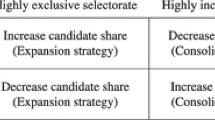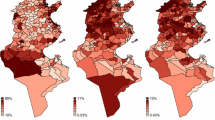Abstract
This study uses empirical spatial theory to evaluate candidate and voter behavior in senate elections contested during the 1989 Chilean general election. The study evaluates whether senatorial candidates competing in dual member districts under Chilean d'Hondt locate near the periphery or interior of the electoral space. Spatial analyses demonstrate the Chilean senatorial electoral system is characterized by centrifugal forces. In particular, candidates of the right locate on the periphery of the space and face few incentives to pursue moderate electoral strategies. The study also characterizes bases of party and candidate support and the underlying dimensions of political competition. Spatial analysis reveals both change and continuity in the pre- and post-authoritarian electoral universes.
Similar content being viewed by others
References
Adams, J. and Merrill III, S. (1998a). A Downsian model of candidate competition in the 1988 French presidential election. Typescript. Santa Barbara: University of California.
Adams, J. and Merrill III, S. (1998b). Party structures and policy representation in multiparty elections: An application to Norwegian politics. Typescript. Santa Barbara: University of California.
Adams, G. (1996). Legislative effects of single-member vs. multi-member districts. American Journal of Political Science40: 129-144.
Aldrich, J.H. and McKelvey, R.D. (1977). A method of scaling with applications to the 1968 and 1972 presidential elections. American Political Science Review71: 111-130.
Anderson, T.W. and Amemiya, Y. (1988). The asymptotic normal distribution of estimators in factor analysis under general conditions. The Annals of Statistics16: 759-771.
Angell, A. (1990). The Chilean elections of 1989. Electoral Studies3: 241-245.
Angell, A. and Pollack, B. (1990). The Chilean elections of 1989 and the politics of the transition to democracy. Bulletin of Latin American Research9: 1-23. Black, D. (1958). Theory of committees and elections. New York: Cambridge University Press.
Brady, H.E. (1991). Traits versus issues: Factor versus ideal-point analysis of candidate thermometer ratings. In J.A. Stimson (Ed.), Political Analysis, Vol. II. Ann Arbor: University of Michigan Press.
Burnett, B.G. (1970). Political groups in Chile. Austin: University of Texas Press.
Cahoon, L.S. and Hinich, M.J. (1976). A method for locating targets using range only. IEEE Transactions on Information Theory22: 217-225.
Cahoon, L.S., Hinich, M.J. and Ordeshook, P.C. (1978). A statistical multidimensional scaling method based on the spatial theory of voting. In P.C. Wang (Ed.), Graphical representation of multivariate data. New York: Academic Press.
Caviedes, C.N. (1991). Elections in Chile: The road toward redemocratization. Boulder: Lynne Rienner Publishers.
Cox, G.W. (1987). Electoral equilibrium under alternative voting institutions. American Journal of Political Science31: 82-108.
Cox, G.W. (1990a). Centripetal and centrifugal incentives in electoral systems. American Journal of Political Science34: 903-935.
Cox, G.W. (1990b). Multicandidate spatial competition. In J.M. Enelow and M.J. Hinich (Eds.), Advances in the spatial theory of voting. New York: Cambridge University Press.
Davis, S.K. (1984). A nonmetric test of spatial theories of elections. Political Methodology10: 1-28.
Denzau, A., Kats, A. and Slutsky, S. (1985). Multi-agent equilibria with market share and ranking objectives. Social Choice and Welfare2: 95-117.
Downs, A. (1957). An economic theory of democracy. New York: Harper and Row.
Eaton, B.C. and Lipsey, R. (1975). The principle of minimum differentiation reconsidered: Some new developments in the theory of spatial competition. Review of Economic Studies42: 27-50.
Endersby, J.W. and Hinich, M.J. (1992). The stability of voter perceptions: A comparison of candidate positions across time using the spatial theory of voting. Journal of Mathematical and Computer Modeling16: 67-83.
Enelow, J.M. (1986). The linkage between predictive dimensions and candidate issue positions in American presidential elections: An examination of group based differences. Political Behavior8: 245-261.
Enelow, J.M. (1988). A methodology for testing a new spatial model of elections. Quality and Quantity22: 347-364.
Enelow, J.M. and Hinich, M.J. (1984). The spatial theory of voting: An introduction. New York: Cambridge University Press.
Enelow, J.M. (1989). The locations of American presidential candidates: An empirical test of a new spatial model of elections. Mathematical and Computer Modeling12: 461-470.
Enelow, J.M. (1994). A test of the predictive dimensions model in spatial voting theory. Public Choice78: 155-170.
Enelow, J.M. and Hinich, M.J. (Eds.). (1990). Advances in the spatial theory of voting. New York: Cambridge University Press.
Faundez, J. (1988). Marxism and democracy in Chile. New Haven: Yale University Press.
Garreton, M.A. (1989). The Chilean political process. Winchester, MA: Unwin Hyman.
Gill, F.G. (1966). The political system of Chile. Chapel Hill: University of North Carolina Press.
Green, D.P. and Shapiro, I. (1994). Pathologies of rational choice theoryNew Haven: Yale University Press.
Greenberg, J. and Shepsle, K. (1987). The effect of multiparty rewards in multiparty competition with entry. American Political Science Review81: 525-537.
Greenberg, J. and Weber, S. (1985). Multiparty equilibria under proportional representation. American Political Science Review79: 693-703.
Hinich, M.J. and Mungeer, M.C. (1994). Ideology and the theory of political choice. Ann Arbor: University of Michigan Press.
Hinich, M.J. (1996). Analytical politics. New York: Cambridge University Press (forthcoming).
Hinich, M.J. and Ordeshook, P.C. (1970). Plurality maximization versus vote maximization: A spatial analysis with variable participation. American Political Science Review64: 772-791.
Iversen, T. (1994). Political leadership and representation in West European democracies: A test of three models of voting. American Journal of Political Science38: 45-74.
Jones, M.P. (1993). The political consequences of electoral laws in Latin America and the Caribbean. Electoral Studies12: 59-75.
Langton, K.P. and Rapoport, R. (1976). Religion and leftist mobilization in Chile. Comparative Political Studies9: 277-308.
Laver, M. and Schofield, N. (1990). Multiparty government. New York: Oxford University Press.
Lijphart, A. (1994). Electoral systems and party systems. New York: Oxford University Press.
Lin, T.-M., Chu, Y.-h. and Hinich, M.J. (1996). Conflict displacement and regime transition in Taiwan: A spatial analysis. World Politics(forthcoming).
Lipset, S.M. and Rokkan, S. (1967). Cleavage structures, party systems and voter alignments. In S.M. Lipset and S. Rokkan (Eds.), Party systems and voter alignments: Cross national perspectives. New York: The Free Press.
Macdonald, S.E., Listhaug, O. and Rabinowitz, G. (1991). Issues and party support in multiparty systems. American Political Science Review85: 1107-1131.
Macdonald, S.E., Rabinowitz, G. and Listhaug, O. (1995). Political sophistication and models of issues voting. British Journal of Political Science25: 453-483.
Merrill, S. III. (1994). A probabilistic model for the spatial distribution of party support in multiparty elections. Journal of the American Statistical Association1190-1197.
Merrill, S. III. (1995). Discriminating between the directional and proximity spatial models of electoral competition. Electoral Studies14: 273-287.
Palfrey, T.R. (1984). Spatial equilibrium with entry. Review of Economic Studies51: 139-156.
Panzer, J. and Paredes, R. (1991). The role of economic issues in elections: The case of the 1988 Chilean presidential referendum. Public Choice71: 51-59.
Poole, K. and Rosenthal, H. (1984). U.S. presidential elections 1968-1980: A spatial analysis. American Journal of Political Science28: 282-312.
Portes, A. (1976). Occupation and lower-class political orientation in Chile. In A. Valenzuela and J.S. Valenzuela (Eds.), Chile: Politics and society. New Brunswick: Transaction Books.
Rabinowitz, G. (1978). On the nature of political issues: Insights from a spatial analysis. American Journal of Political Science70: 804-809.
Rabinowitz, G. and Macdonald, S.E. (1989). A directional theory of issue voting. American Political Science Review83: 93-121.
Rabinowitz, G., Macdonald, S.E. and Listhaug, O. (1991). Old players in a new game: Party strategy in multiparty systems. Comparative Political Studies24: 147-185.
Rusk, J. and Weisberg, H. (1972). Perceptions of presidential candidates. Midwest Journal of Political Science16: 388-410.
Sartori, G. (1976). Parties and party systems. New York: Cambridge University Press.
Schofield, N., Martin, A., Quin, K. and Whitford, A. (1998). Multiparty electoral competition in the Netherlands and Germany: A model based on the multinomial probit. Public Choice(forthcoming).
Schofield, N. (1998). A comparison of majoritarian and proportional electoral systems based on spatial modeling and ‘rational’ politicians. Typescript. St. Louis: Washington University.
Scott, D.W. (1992). Multivariate density estimation. New York: Wiley.
Scully, T.R. (1992). Rethinking the center: Party politics in nineteenth-and twentieth-century Chile. Stanford: Stanford University Press.
Scully, T.R. (1995). Reconstructing party politics in Chile. In S. Mainwaring and T.R. Scully (Eds.), Building democratic institutionsStanford: Stanford University Press.
Shepsle, K.A. (1991). Models of multiparty electoral competition. New York: Harwood Academic.
Shepsle, K.A. and Cohen, R.N. (1990). Multiparty competition, entry and entry deterrence in spatial models of elections. In J.M. Enelow and M.J. Hinich (Eds.), Advances in the spatial theory of voting. New York: Cambridge University Press.
Taagepera, R. and Shugart, M.S. (1989). Seats and vote. New Haven: Yale University Press.
Valenzuela, A. (1985). Origins and characteristics of the Chilean system: A proposal for a parliamentary form of government. Working Paper No. 164, The Woodrow Wilson Center.
Valenzuela, S. and Valenzuela, A. (1985). Chile and the breakdown of democracy. In H.J. Wiarda and H.F. Kline (Eds.), Latin American politics and development. Boulder: Westview Press.
Valenzuela, A. and Valenzuela, S. (1986). Party opposition under the authoritarian regime. In A. Valenzuela and J.S. Valenzuela (Eds.), Military rule in Chile. Baltimore: The Johns Hopkins University Press.
Walker, I. (1993). Political alliances and the role of the centre: The Chilean Christian Democratic Party. In A. Angell and B. Pollack (Eds.), The legacy of dictatorship. Liverpool: Institute of Latin American Studies.
Weisberg, H. and Rusk, J. (1970). Dimensions of candidate evaluation. American Political Science Review64: 1167-1185.
Author information
Authors and Affiliations
Rights and permissions
About this article
Cite this article
Dow, J.K. A spatial analysis of candidate competition in dual member districts: The 1989 Chilean senatorial elections. Public Choice 97, 451–474 (1998). https://doi.org/10.1023/A:1005014611991
Issue Date:
DOI: https://doi.org/10.1023/A:1005014611991




